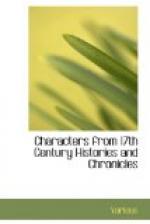There is no character of Milton. We have again to be content with notes for a character.
Page 192, l. 7. Christ’s College, Cambridge, which Milton entered in February 1625, aged sixteen.
ll. 15-18. Milton had three daughters, by his first wife—Anne, Mary, and Deborah. Mary died unmarried. Deborah’s husband, Abraham Clarke, left Dublin for London during the troubles in Ireland under James II: see Masson’s Life of Milton, vol. vi, p. 751. He is described by Johnson as a ‘weaver in Spitalfields’: see Lives of the Poets, ed. G.B. Hill, vol. i, pp. 158-60.
Page 193, ll. 2-4. Litera Canina. See Persius, Sat. i. 109 ‘Sonat hic de nare canina littera’; and compare Ben Jonson, English Grammar, ‘R Is the Dogs Letter, and hurreth in the sound.’
ll. 11, 12. But the Comte de Cominges, French Ambassador to England, 1662-5, in his report to Louis XIV on the state of literature in England, spoke of ’un nomme Miltonius qui s’est rendu plus infame par ses dangereux ecrits que les bourreaux et les assassins de leur roi’. This was written in 1663, and Cominges knew only Milton’s Latin works. See J.J. Jusserand, A French Ambassador at the Court of Charles the Second, 1892, p. 58, and Shakespeare en France, 1898, p. 107.
l. 19. In toto nusquam. Ovid, Amores, i. 5. 18.
Page 194, l. 4. Milton died November 8: see Masson, Life of Milton, vol. vi, p. 731.
58.
Letters of State, Written by Mr. John Milton, To most of the Sovereign Princes and Republicks of Europe. From the Year 1649 Till the Year 1659. To which is added, An Account of his Life.... London: Printed in the Year, 1694. (p. xxxvi.)
‘The Life of Mr. John Milton’ (pp. i-xliv) serves as introduction to this little volume of State Papers. It is the first life of Milton. Edward Phillips (1630-96) was the son of Milton’s sister, and was educated by him. Unfortunately he failed to take proper advantage of his great opportunity. The Life is valuable for some of its details, but as a whole it is disappointing; and it makes no attempt at characterization. The note on Milton in his Theatrum Poetarum, or a Compleat Collection of the Poets, 1675, is also disappointing.
59.
Explanatory Notes and Remarks on Milton’s Paradise Lost. By J. Richardson, Father and Son. With the Life of the Author, and a Discourse on the Poem. By J.R. Sen. London: M.DCC.XXXIV. (pp. iii-v; xciv; c; cxiv.)
Jonathan Richardson (1665-1745) was one of the chief portrait-painters of his time. There are portraits by him of Pope, Steele, and Prior—all now in the National Portrait Gallery; and his writings on painting were standard works till the time of Reynolds. His book on Milton was an excursion late in life, with the assistance of his son, into another field of criticism. His introductory life of Milton (pp. i-cxliii) is a substantial piece of work, and is valuable as containing several anecdotes that might otherwise have been lost. Those that bear on Milton’s character are here reproduced. The typographical eccentricities have been preserved.




